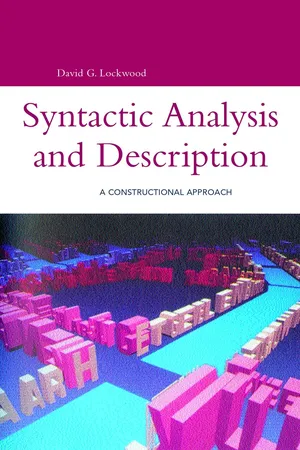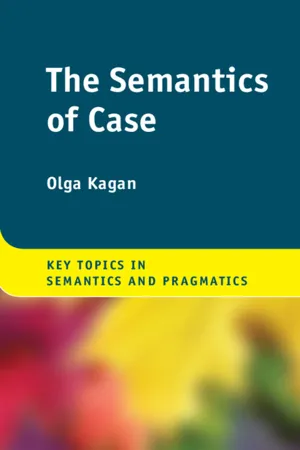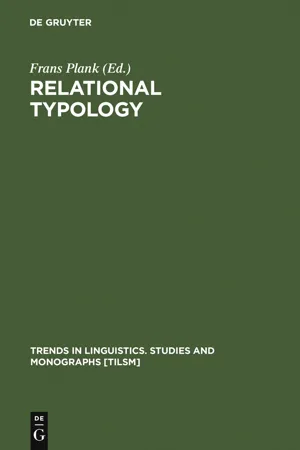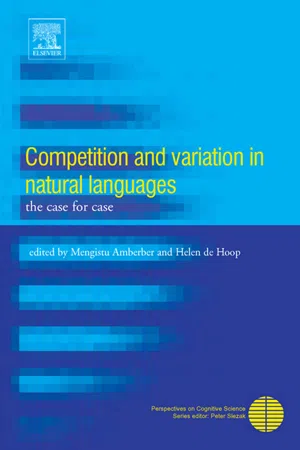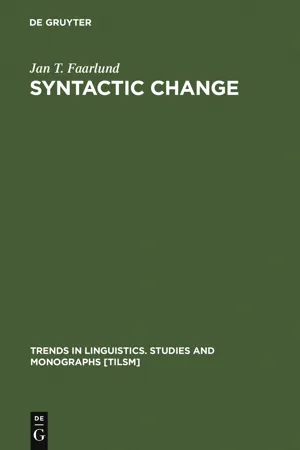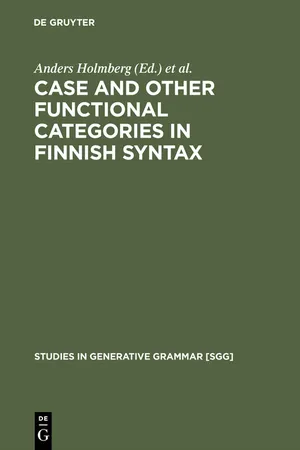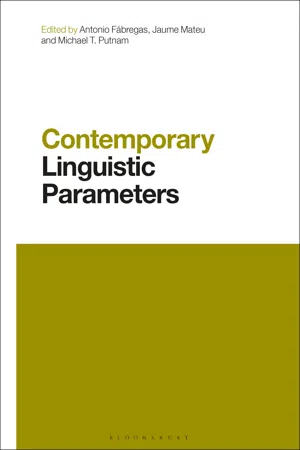Languages & Linguistics
Accusative
The accusative case is a grammatical case used to indicate the direct object of a transitive verb in many languages. It typically marks the noun or pronoun that is the recipient of the action of the verb. In some languages, the accusative case also indicates motion towards a specific location.
Written by Perlego with AI-assistance
Related key terms
1 of 5
11 Key excerpts on "Accusative"
- eBook - PDF
Syntactic Analysis and Description
A Constructional Approach
- David Lockwood(Author)
- 2003(Publication Date)
- Continuum(Publisher)
10 Varieties of clausal organization: Accusative, ergative, and others Accusative and ergative perspectives illustrated In many languages of the world, case inflection is used to distinguish grammatical functions of at least some nominal words. The Russian data in Table 10.1 displays a pattern of such inflection that is typical of European languages, but also found widely in various parts of the world. In items 1 through 10, we see examples of transitive clauses with the order Subject + Predicator + Object. When we see the same noun sometimes as Subject and sometimes as Object, we observe that they have different suffixes according to their function. The group including Ivan has no suffix in the Subject function, but the suffix -a when occurring as Object. The other group, including Masa, has the suffix -a for the Subject and the suffix -u for the Object. The intransitive examples in items 11-15, furthermore, show the expected Subject forms for the only nouns that appear with them. Modern English has exactly the same pattern, but it is restricted in its occurrence: whereas most nominals in a language like Russian show different forms for these different functions, no actual nouns show it in English, but it does show up in personal pronoun forms such as /, he, she, we, they for Subjects as contrasted with me, him, her, us, them for Objects. So we find case differences in / see her versus She sees me, but not in John sees Tom versus Tom sees John. Traditional terminology, coming down to us from Latin grammar, refers to the Subject forms in such examples as being in the NOMINATIVE CASE, while the Object forms are in the Accusative CASE. The term nominative is based on Latin nomen NAME, and comes from the fact that this case is normally used in a language like Latin or Russian to simply name the object. The term Accusative is less justified in reality, because it rests on an ancient mistranslation. - eBook - PDF
Reinventing Structuralism
What Sign Relations Reveal About Consciousness
- Rodney B. Sangster(Author)
- 2013(Publication Date)
- De Gruyter Mouton(Publisher)
They represented neither logical nor technical desig-nations, but were rather more textual, if you will, describing how the cases appear as a function of their use in specific utterances. The use of such desig-nations was in keeping with Jakobson’s insistence on the “relative autonomy” of linguistic phenomena–i.e. that our descriptions need to be based in the first instance on phenomena intrinsic to the domain of inquiry in question and not be short-circuited by assumptions extrinsic to that domain, leaving it to others to extend these observations into other areas of cognitive structure. So, in Jakobson’s parlance, a noun would appear in the Accusative case in Russian whenever the verbal action (expressed or implied) was “directed” onto it in such a way that it was fully involved–“The meaning of the Accusative is con-nected with the action so closely and directly that it can be exclusively gov-erned by a verb and its independent use always suggests a missing and implied verb”; or a noun would appear in the genitive case anytime only a certain “quantity” of the phenomenon referred to participated in the utterance situa- The system of Russian cases 67 tion–“the genitive always indicates the limit of the referent’s involvement in the content of the utterance”; and so forth. - eBook - PDF
- Wolfgang U. Dressler, Martin Prinzhorn, John R. Rennison, Wolfgang U. Dressler, Martin Prinzhorn, John R. Rennison(Authors)
- 2011(Publication Date)
- De Gruyter Mouton(Publisher)
It seems no less problematic to label as Accusative the form of the noun considered to be the Grammatical Subject of a passive verb (Kee-nan 1976: 326-328) or the form of bare address. 3. It seems equally problematic to label as Nominative the form of the noun governed by a preposition or a particle. 4. It also seems problematic to label as Accusative the morphologically basic, i.e., unmarked, form of the noun, while its morphologically complex, or marked, form is labeled as Nominative. 4 Using the terms Accusative and nominative in the indicated way disrupts the generally accepted doctrine of Grammatical Case and runs counter to many universalist theories of syntax. It creates difficulties, among other things, for the description of the Maasai passive, since — contrary to other known passives - it is said to take its Grammatical Subject in the Accusative! 5 Keenan (1976) exploits this idea to support his theory of partial subjecthood, saying that the direct object of a transi-tive verb in Maasai becomes, with the passive form of the verb, the de-rived subject that takes on the characteristic position of a basic subject but not its case-marking. This point is convincingly attacked by Perlmut-ter and Postal (1984: 159), but, again, their reasoning is anchored in calling the basic form of the noun the Accusative, so that the confusion remains. I find this terminological usage detrimental to linguistic typology and even more so to all attempts to develop a universal linguistic theory and a corresponding linguistic metalanguage — a formalized coherent system of concepts for the whole of linguistics. 136 Igor Mel'cuk 1.3. The proposal: changing names As far as I can judge, the difficulty here arose, in the first place, because the founders of African linguistics chose to apply case names according to the case's main syntactic function. - eBook - PDF
- Olga Kagan(Author)
- 2020(Publication Date)
- Cambridge University Press(Publisher)
Consider the following three types of arguments: the subject of a transitive verb, the object of a transitive verb and the subject of an intransitive verb. Which of these will appear in the same case and which will receive a separate marking? In nominative-Accusative (or Accusative) languages, such as Japanese, Russian and German, the subject of an intransitive verb receives the same marking as the subject of a transitive one. Both appear in the nominative case. In contrast, the object of a transitive verb receives a different, Accusative, form. Table 1.2 Finnish case system (the noun ihminen ‘man’ and the noun talo ‘house’ for the last three cases; based in part on Korpela 2015) Case Form Function Parallels with English functional elements nominative ihminen subject Accusative ihmisen object genitive ihmisen possessor a/the man’s; of a/the man partitive ihmista object; complement of a quantifier; complement of a preposition essive ihmisena stage-level predicate, a temporary property or otherwise relativized property as a man translative ihmiseksi change of state (turn) into a man illative ihmiseen goal, internal into a man inessive ihmisessa location, internal in a man elative ihmisesta source, internal from in(side of) a man allative ihmiselle goal, external to a man adessive ihmisella location, external on a man ablative ihmiselta source, external from on a man instructive taloin instrument with (the use of) a house abessive talotta without without a house comitative taloineni together (together) with my house 1.4 Case Systems 17 In contrast, in ergative-absolutive (or ergative) languages, such as Basque and Inuit, the subject of an intransitive verb receives the same marking as the object of a transitive verb. They appear in the absolu- tive case. This time, it is the subject of a transitive verb that gets special marking (ergative). It is worth noting that nominative and absolutive are cases which correspond to the citation form of the noun. - eBook - PDF
- Frans Plank(Author)
- 2011(Publication Date)
- De Gruyter Mouton(Publisher)
But there are stages of this overall development, notably in Medieval Latin, where this interpretation is no doubt justified, insofar as the use of the Accusative was extended while still in paradigmatic contrast with the nominative. Considering that Medieval Latin in its various manifestations, unlike other varieties of Late Latin or of the emerging national Romance languages, was no one's native language, but had to be learned in schools as a second language by all those speaking and writing it, it would actually be surprising if its speakers and writers had always performed faultlessly. Though Medieval Latin (es-pecially prior to the Carolingian Reform in the mid-8th century) certainly was no 'dead' and static language comparable to the later Humanistic Latin, nor a pidgin in the sense of serving only rather rudimentary needs of communication (it was, on the contrary, the language of the intellectual life of the Middle Ages!), the extant manuscripts contain a fair share of grammatical lapses, in principle recognisable as errors by authors or scribes and their educated readers. Some of these look like errors in the use of the case forms that interest us here, with Accusatives appearing where the norms of Latin would lead one to expect nominatives. Frequently these errors can be explained as due to contaminations of active and passive constructions: what begins as an active construction, with the object accordingly in the Accusative, is concluded, often with several subordinate clauses in between, as a passive verbal con-struction that would have required the initial actant to be in the nominative (see Norberg 1944: 21-32 for numerous examples). The extended Accusative I restricted nominative 2 8 9 Interferences from the spoken popular languages, with their more advanced reduction of the case system, may have been another source of erroneous uses of Accusative forms instead of nominatives. - eBook - PDF
Competition and Variation in Natural Languages
The Case for Case
- Mengistu Amberber, Helen de Hoop(Authors)
- 2005(Publication Date)
- Elsevier Science(Publisher)
Chapter 7 The Case of Basque: An Accusative Analysis for an Ergative System Mario van de Visser 1. Introduction Every natural language is thought to distinguish between intransitive and transi-tive predicates. The former take only one argument, called intransitive subject ( S ), whereas the latter take at least two arguments, a transitive subject ( A ) and a direct object ( O ). In a nominative/Accusative system, S and A are treated alike, whereas O is treated differently. This is illustrated by the German sentences below: 1 (1) a. Ich geh-e 1 SG go. PRS -1 SG ‘I am going’ b. Du geh-st 2 SG go. PRS -2 SG ‘You are going’ c. Ich wasch-e dich 1 SG wash. PRS -1 SG 2 SG . ACC ‘I am washing you’ d. Du wäsch-st mich 2 SG wash. PRS -2 SG 1 SG . ACC ‘You are washing me’ Competition and Variation in Natural Languages: The Case for Case Edited by M. Amberber and H. de Hoop Copyright © 2005 by Elsevier Ltd. All rights of reproduction in any form reserved ISBN: 0-08-044651-5 1 The following abbreviations are used in the glosses: ( A ) Transitive Subject; ACC Accusative case; ( IO ) Indirect Object; ERG Ergative case; FEM Feminine; FAM Familiar; IMP Imperfective aspect; MASC Masculine; PL Plural; PRS Present tense; 1/2/3 1st, 2nd, 3rd person; SG Singular. 179 The first person singular pronoun ich ‘ I’ functions as an intransitive subject in (1a), and as a transitive subject in (1c). This is the Nominative case, which I have omitted in the glosses because of presentational reasons. Whenever this pronoun functions as a direct object, as in (1d), a different form is used: mich ‘me’. This is the Accusative case. Agreement morphology follows this nomi-native/Accusative pattern closely: the verb agrees with nominative arguments only. Basque, on the other hand, shows a completely different pattern: (2) a. Ni ibil-tzen naiz 1 SG walk-IMP 1 SG . PRS .be ‘I am walking’ b. Zu ibil-tzen zara 2 SG walk-IMP 2 SG . PRS .be ‘You are walking’ c. - eBook - PDF
Syntactic Change
Toward a Theory of Historical Syntax
- Jan T. Faarlund(Author)
- 2011(Publication Date)
- De Gruyter Mouton(Publisher)
5.1.1. Case system of Old Norse In Old Norse there are four cases, nominative, dative, Accusative, and genitive, all of which are used for NP arguments of verbs. Since this is a nonconfigurational language, all NP arguments are governed by the verb, including the subject. Then the list of cases also makes the specification of the number of arguments redundant. The lexical entry for the verb bera 'carry', for example, may include the following specifications: (8) bera Verb 'carry' nominative dative Accusative The verb bera governs three NPs; the sentence associates with a case tier with the cases nominative, dative, and Accusative. The semantic roles do not need to be specified in the lexicon; it follows from the number of cases that they have to be three in number, and it follows from the meaning of the verb that they are Agent, Locus, and Theme. An example of such a sentence is (9a). The associations may be illustrated as in (9b) (ignoring the additional complications arising from the auxiliary verb.) Case systems 141 (9) a. Hon skyldi bera QI vOdngum she-N should carry beer-Α vikings-D 'She was to bring beer to the vikings' (Heimskringla) b. bera Role tier: Agent Theme Locus Case tier: Nominative Accusative Dative hon vikingum In a nonconfigurational language with morphological case-marking, the argument phrase and its governor do not have to be adjacent. The case-marking will secure the correct identification. Consider again examples like those in (37) in Chapter Four. One of them is repeated here as (10a); the associations are shown in (10b). There are two predicates, the verb hqggva and the preposition af. The verb is specified for nominative and Accusative, and the preposition for dative. The two arguments of a verb meaning 'cut' have the roles of Agent and Theme, and the argument of a preposition meaning 'off has the role of Locus. - Anders Holmberg, Urpo Nikanne, Anders Holmberg, Urpo Nikanne(Authors)
- 2015(Publication Date)
- De Gruyter Mouton(Publisher)
(On the assignment of the semantic cases, see Nikanne (this volume).) The case pattern is a property of the head, and different heads can assign different cases in the same position. We will see in section 1.2 that the nominative in position 1 is typical for the case pattern of finite verbs, whereas participial verbs have the genitive in position 1 of their case patterns. Of the better-known theories of syntax the Case Tier Theory of Yip, Maling and Jackendoff (1987) and Maling (this volume) resembles the present theory most, because in both approaches there is a case pattern which has an independent status in case-marking. This paper investigates the nature of the Accusative as a case with no ending of its own in modern Finnish and as a marker of the most informative noun phrase in the transitive sentence, the object. The Accusative has competitors in the area of the object complement: the nominative has retained its status in the plural and in subjectless clauses, and it has even been expanded to all personal pronouns. The partitive is said to be the marker of a partial object 3 , but it has a fatal connection with the Accusative, called the total object case: the preceding quantifier is in the Accusative, and there is always one present if not deleted as a very general phrase (meaning 'some'). Regarding terminology, I shall here restrict the term 'Accusative case' to the singular forms having some ending. Generally the ending is n, e.g.: Matti naki auto+n (Matti saw car+ACC) 'Matti saw a car'. I Generally speaking, the partitive in Finnish is primarily the case of the verbal complement (object and predicative) in any kind of sentence meaning non-entirety or even negation. It contrasts with the basic cases for complements, the nominative and Accusative (Toivainen 1977, 2985, in prep.). 114 Jorma Toivainen The total objects in the plural are assumed to be in the nominative case. An explanation will be proposed for the lack of plural Accusative forms.- eBook - PDF
- Ewa Dabrowska(Author)
- 2011(Publication Date)
- De Gruyter Mouton(Publisher)
Introduction 99 Thus, although the prototypical sense of the Accusative case is very different indeed from the target person prototype, the more peripheral uses seem to cover more or less the same ground as some uses of the dative. Specifically, if an agent's action causes a certain emotional state in another participant, that participant is certainly affected, which motivates the use of the Accusative case. On the other hand, the non-active participant experiences an emotion, and emotions, I argued earlier, are conceptualized as processes occurring in the sphere of awareness; this, in turn, motivates the use of the dative case. The choice of case category, I will argue in this chapter, depends on whether the verb profiles the agent's action and the target's affectedness as a single act of causation or whether the agent's action is seen as sparking off an autonomous process in another participant's sphere of awareness. In the case of verbs such as ucieszyc 'to please, delight', rozweseli6 'to cheer up', rozsmieszyt 5 'to amuse, make laugh', rozbawiö 'to amuse', zasmucii 'to make sad', przygn^bic 'to depress, deject', rozgoryczyö 'to embitter', rozzalii 'to aggrieve, dispirit', zmartwic 'to worry', zaktopotad 'to nonplus, perplex', strapic 'to distress, afflict', rozczarowac 'to disappoint', zawstydzid 'to embarass', oniesmielic 'to daunt, overawe', etc., the agent's actions and the target's affectedness are clearly one and the same event, and hence all of these verbs govern the Accusative. 47 Other verbs profile only the first part of this chain of causation, and hence the affected person is given dative case marking. The difference is once again a matter of construal, though some types of events more amenable to the dative construal than others. One type of action which naturally lends itself to the dative construal is communication. - Ans van Kemenade(Author)
- 2016(Publication Date)
- De Gruyter Mouton(Publisher)
This leaves one group of oblique Accusative objects of which we can be reasonably certain, albeit on theory-internal grounds; on the assumption that Ρ always assigns oblique case, we must look at instances where Ρ assigns Accusative case. This phenomenon is limited to a fixed set of prepositions: geond 'throughout, along', oJ) 'until', vmb 'around', burh 'through', in 'into', ofer 'over, a-cross', on 'into', wid 'against;. Strikingly, these prepositions must be assumed to assign a O-role of 'goal', one that we have concluded above is associated with dative case. There is a clear difference, however, between dative and Accusative case in this respect. Whereas the dative case assigned by Ρ is asso-ciated with 'goal' in a locative, static sense, Accusative assigned by Ρ re-ceives a dynamic, motional reading. It indicates movement towards something. Nevertheless, it seems that this is counterevidence for our hypothesis that dative case correlates with 'goal*. However, this is not necessarily so. Note first that among the oblique case markers, Ρ is the only head that has the feature specification [-V], alongside the [-N] specification. It seems quite 85 possible that therefore thematic correlations work out in a different way for such elements. Against that background it seems plausible to regard Accusative case assigned by Ρ as a subcase of dative case, used to indicate motion. This assumption derives some support from the fact that all the prepositions that assign Accusative case have an alternative of assigning dative, but not the other way around. Moreover, already in OE, Accusative case assigned by Ρ levels to dative case. 3.1.1.3. Some preliminary conclusions In this section we have established how structural syntactic case differs from oblique syntactic case in important respects. There are at least two major differences between the two that are pervasive throughout the syntax.- eBook - PDF
- Antonio Fabregas, Jaume Mateu, Michael Putnam(Authors)
- 2015(Publication Date)
- Bloomsbury Academic(Publisher)
By placing case assignment (and agreement) in the post-syntactic morphological component in this way, Marantz denies any syntactic difference between ergative and Accusative systems. All that is at stake is a rather superficial fact of morphology. The attraction of such an approach lies in its simplicity and the parallels between Accusative and ergative which Marantz describes. As he further notes, a system which places case / agreement in the morphological component is better placed to handle case / agreement mismatches of the kind described in section 3.3.3. Baker (2014, 2015) shows that a variant of this approach can account for a range of facts, including the interaction with differential marking of the kind described in section 3.2.3. A potential challenge for the approach comes from the existence of syntac-tically ergative and high absolutive languages, which suggests that the syntax of (some) ergative systems differs from that of their Accusative counterparts. 3.4.6. Ergative as an inherent Case An approach which has also gained popularity in the recent generative literature is the idea that ergative is an inherent case (see Mahajan 1989; Massam 1994; Woolford 1997, 2006a; Aldridge 2004, 2008a; Legate 2008, 2012). As Woolford (2006a) notes, ergative is often classified as a structural case based on mistaken diagnostics, notably because it is a pervasive feature of transitive clauses. As she notes, independently of ergativity, UG must allow for theta-related cases which are assigned to specific structural positions, because of the existence of dative case which is assigned to goals / beneficiaries / experiencers in many languages. Ergative, she claims, is just the theta-related inherent case associated with external arguments. Evidence for this position comes from the fact that (i) there is no raising to ergative (Marantz 1991), but (ii) ergative subjects can undergo raising in some languages (Woolford 1997).
Index pages curate the most relevant extracts from our library of academic textbooks. They’ve been created using an in-house natural language model (NLM), each adding context and meaning to key research topics.
